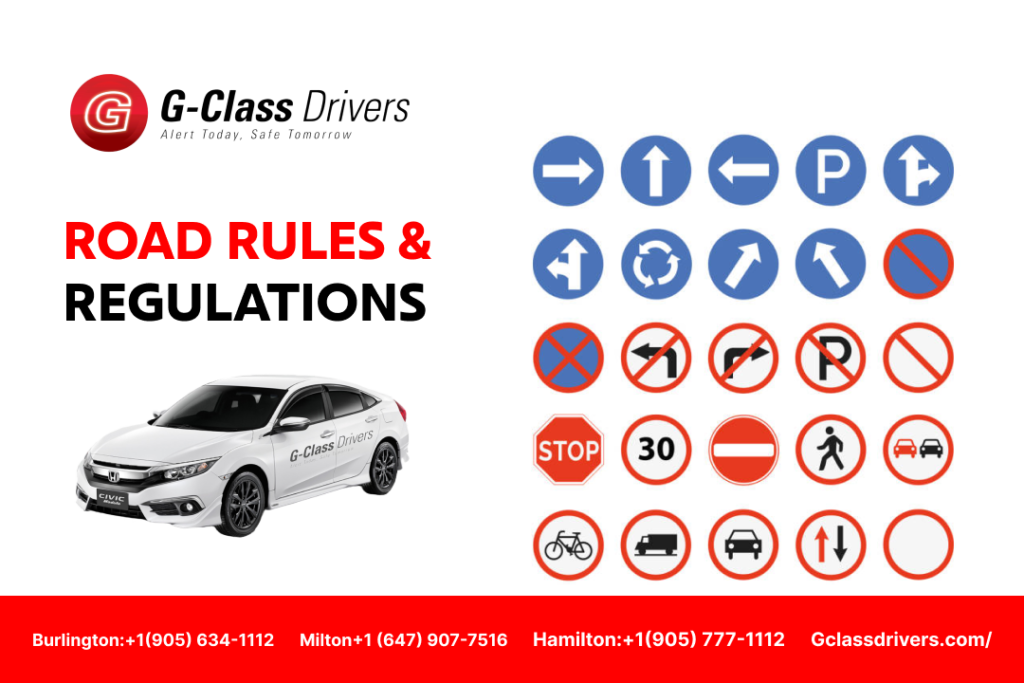Being a mindful driver takes a blend of information, expertise, and knowledge. The basic thing to being a successful driver is to know about road rules & regulations. Familiarizing yourself with your area’s road rules and ordinances is important. By following the driving safety rules and road laws, we can ensure our own safety and that of others.
Administrative, federal, and civil states make traffic regulations. Police from the relevant area have the power to enforce them. You might be fined or sent to prison if you violate a traffic law. There is also a chance that you might lose your driver’s permit. Because of a suspended license, your vehicle might be seized.
Road Rules & Regulations
Here is a set of rules and regulations that you should follow when you are driving. So let’s know each rule in more detail.
Wear Seat belt
Seat belts play a role in life and death. The use of seatbelts is mandatory for all passengers. Wearing a seat belt is very important before driving. In case of any accident, it proves a savior. That’s why if you are not wearing a seatbelt and caught you will be charged by motorway police.
Speed Limits
Speed more than limit is one of the most important factors causing accidents. Usually, you will see speed limits range from 30 km/h to 100 km/h. It depends on whether you’re in town or on the highway. Have you ever seen speed limit signs on the roadside? Yes of course you see speed limit signs set up on all roadways to indicate the maximum allowed speed
The highway’s minimum speed is 60 km/h, and the maximum is 100 km/h. On most Canadian highways, speeds of up to 120 km/h are considered acceptable.
Get Your Driver’s License
You need a driver’s license to drive in Canada. The process to become a fully licensed driver depends on the province you live in. For example, in Ontario, there is a graduated licensing system. This means you must go through different levels of licenses over four years.
Driving without a valid license is a serious offense. If you are caught, you may have to pay a fine between $200 and $1,000.
Also, if you have a G1 or G2 license and break the rules of the graduated licensing system, your license could be suspended.
Turning Right on a Red Light
In most parts of Canada, you’re allowed to turn right at a red light. But there are two exceptions:
- On the Island of Montréal, it’s not allowed.
- At intersections with signs that say you can’t.
If you decide to turn right on a red light, here’s what to do:
- Stop First: Always come to a full stop before the stop line or the pedestrian crossing.
- Watch for Pedestrians: If pedestrians have a walk signal, they get to go first. Even without a signal, they still have the right-of-way on a green light.
- Go When It’s Safe: Turn only if the road is clear.
Turning right on a red is optional but you don’t have to do it. If another driver chooses not to turn, that’s completely okay. Don’t beep or pressure them. That’s why be patient and courteous, this makes the road safer for everyone!
Pedestrians Right
In Canada, pedestrians always have the right-of-way at crosswalks, but this is a rule many drivers almost forget. It’s important to stop at
- Stop signs
- Intersections
- Traffic lights to let pedestrians cross safely.
You must make sure they’ve completely crossed the street before you move forward. It’s not just about following the law it’s about keeping everyone safe and avoiding any unnecessary risks.
Stopping for School Buses
When a school bus has its red lights flashing and stop arm extended:
- Traffic in both directions must stop.
- Stay at least 5 meters away.
- Don’t move until the lights are off, the stop sign retracts, and the bus moves.
Children must use a booster or safety seat until they reach the required age or weight. Following these rules keeps kids safe on the road.
Don’t Drive With Handheld Devices
In Canada, it’s illegal to use a handheld device when you are driving. Don’t use your phone while driving, texting or making calls can divert your attention from driving. This may result in an accident and injury. The rules are strict. For example, in Alberta, if you’re caught using a handheld device, you could get a $287 fine and three demerit points.
Smoking while driving is still allowed for now, but there are talks about banning it in the future.
To keep everyone safe, put your phone away, stay focused, and avoid distractions while driving.
Green Light Against Flashing Green
In Canada, there are two types of green lights:
- Green Light
- Flashing Green
A green light has the same meaning as in Europe. However, a flashing green light indicates that you have the right of way to make a left turn.
Aggressive Driving
Aggressive driving includes behaviors like speeding, tailgating, running red lights, or cutting in and out of traffic. It usually happens when people are stressed or in a hurry. To avoid it,
- Plan ahead
- Stay calm
- Don’t let mistakes on the road upset you
If another driver is being aggressive, just stay safe and don’t react. Being patient and kind makes the road safer for everyone. The thing you can do is a maintain healthy distance to keep yourself safe.
Bicycles
Bicycles and bikes are also vehicles, so riders need to follow the same rules. If you’re riding a bike, remember these safety rules:
- If you’re under 18, you must wear a helmet.
- Every bike and bicycle should have a bell or horn, lights, reflectors, and reflective tape to keep you safe.
Road Sharing
Always check your blind spots, especially around big vehicles like trucks and buses. Don’t Drive too close and give enough space to larger vehicles. Keep in mind when turning left, be careful of smaller vehicles like motorcycles.
Big vehicles like trucks need more space to stop, so leave plenty of room. For this, you must check your blind spots often and use your signals. To avoid sudden accidents drive carefully on hills and be aware of low bridges or overpasses.
Rules for Driving in Snowplows
New rules to follow Snowplow operators often work in times of poor visibility. If you are following too closely, then there are chances you could be driving blind which is extremely dangerous. Drivers must not pass a snowplow when:
The view along the side of the snowplow is blocked passing would delay the operation of the snowplow the act of passing cannot be done safely Patience is key. Operators will let you pass every 5 to 8 kilometres, or when it is safe to do so.
Emergency Situations
When you hear an emergency vehicle’s siren, pull over to the right side of the road and stop until it passes. Don’t drive within 150 meters of it. If you’re in an intersection and can’t move, stay as far away from the center as you can. On highways, pull over to the nearest curb, usually the right one. Always give emergency vehicles space.
Roadside Workers
When you see roadside workers or emergency vehicles with flashing lights, move to the far lane if possible. If you can’t, slow down to 60 km/h or the speed limit (whichever is lower). If you don’t follow these rules, you could get a fine of $243 and 3 demerits. Always be careful, give workers space, and listen to emergency workers.
Why Choose G-Class Drivers School?
At G-Class Drivers School, we are committed to transforming you into a confident and capable driver. Our expertise lies not only in teaching the rules of the road but also in empowering you with the skills needed to handle real-world driving scenarios.
Here’s why we stand out
- Comprehensive Training: We go beyond the basics. Our expert instructors teach road safety, defensive driving, and advanced driving techniques tailored to Canadian road regulations.
- Certified and Experienced Instructors: Our team of licensed professionals ensures every student receives personalized and effective instruction.
- Real-World Simulations: From handling four-way stops to mastering parallel parking, we provide hands-on practice for every situation.
- Flexible Learning Options: With customizable schedules, we make learning easy for everyone, no matter how busy your life is.
- Proven Success Rate: Our students consistently pass their tests on their first try and become safe drivers for life.
How We Can Help You?
- For New Drivers: We make the transition from learner to licensed driver smooth with step-by-step guidance and support.
- For Nervous Drivers: Our patient instructors specialize in helping drivers overcome anxiety, building their confidence one lesson at a time.
- For Experienced Drivers: Looking to polish your skills or adapt to Canadian road rules? We provide refresher courses customized to your needs.
At G-Class Drivers School, your safety and success are our priority. When you choose us, you’re not just learning to drive investing in a lifetime of safe, stress-free driving. Let us help you master the road with confidence.
FAQs
Can I turn right on red in Canada?
Yes, unless a sign says otherwise. In Quebec, it’s not allowed on the Island of Montreal.
What is a 4-way stop in Canada?
At a 4-way stop, the first vehicle to arrive has the right of way. If two arrive at the same time, the vehicle on the right goes first.
Can I drive in Canada as a tourist?
Yes, you can drive with a valid driver’s license from your home country, and some provinces may require an International Driving Permit (IDP).
What is the highest speed limit in Canada?
The highest speed limit is 120 km/h (75 mph) on certain highways in British Columbia.





